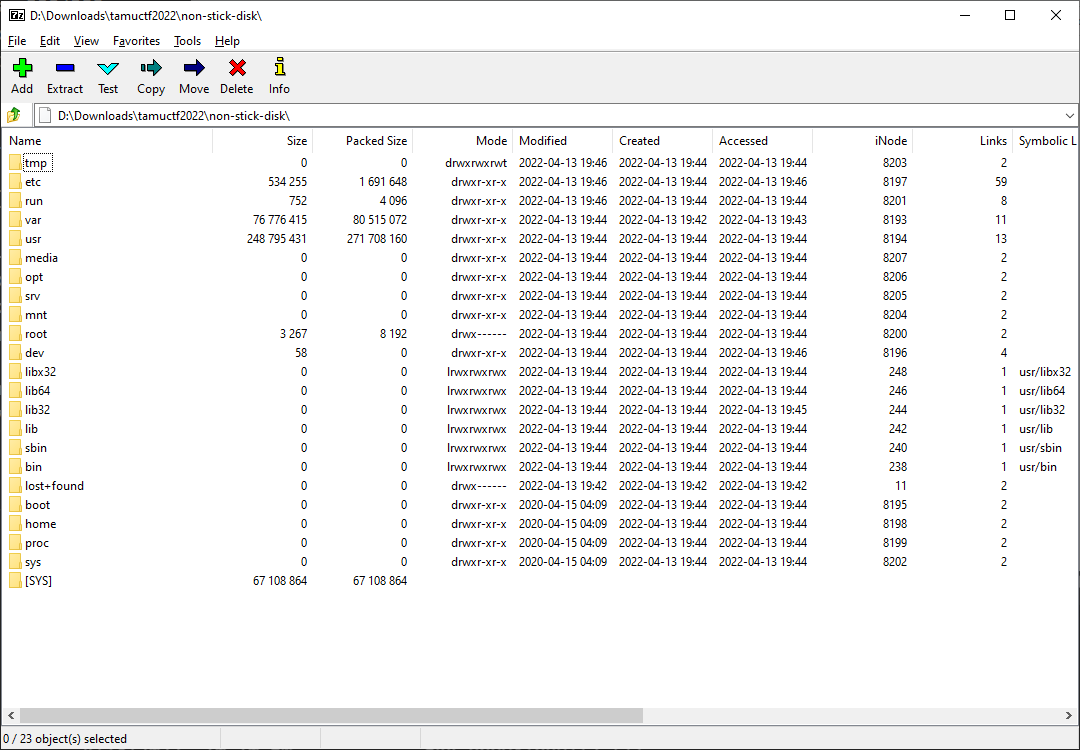Challenge
Author:
Addison
We’ve established a persistence mechanism on the attached disk. Can you determine what that is?
Hint: the flag is in the standard format. You’ll know it when you see it. :)
- Solves: 2 (first blood)
- Points: 500/500
- Category: Forensics
Snooping around
Since we are provided with a .zlib file, we can start by inflating it and figuring out the file format. Just like in UTCTF’s IRC, a quick run of the same commands can give us a good idea of what we are dealing with:
$ openssl zlib -d < non-stick-disk.zlib > non-stick-disk
$ file non-stick-disk
non-stick-disk: Linux rev 1.0 ext4 filesystem data, UUID=72fbaadf-5159-4ab8-ffff90dd-2c3748050d93 (extents) (64bit) (large files) (huge files)
Ah, so that’s what it means by attached “disk” - the file is essentially copy of the ext4 partition on a disk. Funnily enough, 7-zip can actually read this without the need for mounting the file as a drive:

Our task is to figure out the persistence mechanism, so let’s start with looking into the usual locations for code persistence, such as cron.d or init.d.

Hmm, the timestamps are all much older than what would be a feasible creation date of the challenge. Let’s look into the contents just to be sure:
#!/bin/sh
### BEGIN INIT INFO
# Provides: console-setup.sh
# Required-Start: $remote_fs
# Required-Stop:
# Should-Start: console-screen kbd
# Default-Start: 2 3 4 5
# Default-Stop:
# X-Interactive: true
# Short-Description: Set console font and keymap
### END INIT INFO
if [ -f /bin/setupcon ]; then
case "$1" in
stop|status)
# console-setup isn't a daemon
;;
start|force-reload|restart|reload)
if [ -f /lib/lsb/init-functions ]; then
. /lib/lsb/init-functions
else
log_action_begin_msg () {
echo -n "$@... "
}
log_action_end_msg () {
if [ "$1" -eq 0 ]; then
echo done.
else
echo failed.
fi
}
fi
log_action_begin_msg "Setting up console font and keymap"
if /lib/console-setup/console-setup.sh; then
log_action_end_msg 0
else
log_action_end_msg $?
fi
;;
*)
echo 'Usage: /etc/init.d/console-setup {start|reload|restart|force-reload|stop|status}'
exit 3
;;
esac
fi
Yep, looks just like a normal startup script. Digging around in cron.d also reveals nothing special - was it perhaps not referring to this kind of persistence?
Since a lot of the directories are actually emptied, it narrowed the scope enough that we can do a manual search for any suspicious new files. However, upon searching, there still isn’t much to look at, even in the log files.
2022-04-13 21:42:33 URL:http://archive.ubuntu.com/ubuntu/dists/focal/InRelease [264892/264892] -> "/home/addisoncrump/git/tamuctf-2022/forensics/non-stick-disk/mnt/var/lib/apt/lists/partial/archive.ubuntu.com_ubuntu_dists_focal_InRelease" [1]
gpgv: Signature made Thu 23 Apr 2020 12:34:17 PM CDT
gpgv: using RSA key 3B4FE6ACC0B21F32
gpgv: Good signature from "Ubuntu Archive Automatic Signing Key (2012) <ftpmaster@ubuntu.com>"
gpgv: Signature made Thu 23 Apr 2020 12:34:17 PM CDT
gpgv: using RSA key 871920D1991BC93C
gpgv: Good signature from "Ubuntu Archive Automatic Signing Key (2018) <ftpmaster@ubuntu.com>"
2022-04-13 21:42:36 URL:http://archive.ubuntu.com/ubuntu/dists/focal/main/binary-amd64/by-hash/SHA256/7757921ff8feed9c3934a0c9936d441ba4a238bee3ea6c8c1df5cbcd43fc9861 [970408/970408] -> "/home/addisoncrump/git/tamuctf-2022/forensics/non-stick-disk/mnt/var/lib/apt/lists/partial/archive.ubuntu.com_ubuntu_dists_focal_main_binary-amd64_Packages.xz" [1]
2022-04-13 21:42:37 URL:http://archive.ubuntu.com/ubuntu/pool/main/a/adduser/adduser_3.118ubuntu2_all.deb [162792/162792] -> "/home/addisoncrump/git/tamuctf-2022/forensics/non-stick-disk/mnt//var/cache/apt/archives/partial/adduser_3.118ubuntu2_all.deb" [1]
2022-04-13 21:42:38 URL:http://archive.ubuntu.com/ubuntu/pool/main/a/apt/apt_2.0.2_amd64.deb [1288960/1288960] -> "/home/addisoncrump/git/tamuctf-2022/forensics/non-stick-disk/mnt//var/cache/apt/archives/partial/apt_2.0.2_amd64.deb" [1]
2022-04-13 21:42:39 URL:http://archive.ubuntu.com/ubuntu/pool/main/a/apt/apt-utils_2.0.2_amd64.deb [213336/213336] -> "/home/addisoncrump/git/tamuctf-2022/forensics/non-stick-disk/mnt//var/cache/apt/archives/partial/apt-utils_2.0.2_amd64.deb" [1]
2022-04-13 21:42:40 URL:http://archive.ubuntu.com/ubuntu/pool/main/b/base-files/base-files_11ubuntu5_amd64.deb [60132/60132] -> "/home/addisoncrump/git/tamuctf-2022/forensics/non-stick-disk/mnt//var/cache/apt/archives/partial/base-files_11ubuntu5_amd64.deb" [1]
Wait… The log files might have nothing special in it, but since we now know tamuctf is probably in any path related to building this challenge, can’t we just grep for that string and see if there is any hints?
$ strings non-stick-disk | grep 'tamuctf'
(...)
2022-04-13 21:43:51 URL:http://archive.ubuntu.com/ubuntu/pool/main/r/readline/libreadline8_8.0-4_amd64.deb [130880/130880] -> "/home/addisoncrump/git/tamuctf-2022/forensics/non-stick-disk/mnt//var/cache/apt/archives/partial/libreadline8_8U
/home/addisoncrump/git/tamuctf-2022/forensics/non-stick-disk/pam_backdoor/linux-pam-1.3.1/libpam/.libs:/lib64
/home/addisoncrump/git/tamuctf-2022/forensics/non-stick-disk/pam_backdoor/linux-pam-1.3.1/modules/pam_unix
Bingo! The last 2 lines definitely say something about a backdoor, and that is without a doubt related to this challenge. Let’s investigate into it.
Key to the (back)Door
Since the filesystem is for Ubuntu, pam_unix.so most likely resides somewhere in one of the /lib/security paths. Sure enough, this one is found under /usr/lib/x86_64-linux-gnu/security/pam_unix.so. The timestamp is oddly old at 2019-12-17 09:41:40, just like most of the other pam modules - but since the string we found is quite a strong evidence, we might as well at least check it out first.
Opening it in IDA, we are greeted with a DWARF loading prompt:
DWARF: File "D:\Downloads\tamuctf2022\pam_unix.so" contains DWARF information.
DWARF: Functions: 51 symbols applied
DWARF: Globals: 3 symbols applied
Nice! Not only will it help in figuring out what the backdoor is, but it is also likely another indication of us being in the right place, as distributed pam modules are usually stripped of debug information. Since a backdoor in this context most likely involves some form of authentication bypass, checking out the standard pam_sm_authenticate function wouldn’t hurt:

Hmm, this part of the code looks much more complicated than it should. It is comparing the entered password with alternative, and only falling back to the usual unix_verify_password if they don’t match. Then isn’t the data in alternative exactly what we are looking for - a hardcoded backdoor?
The obfuscation code for constructing alternative looks quite simple, so we most likely won’t have to get the entire pam_unix.so running and dynamically obtain the resultant value. By cleaning up the decompiler output and referencing the xmmword_*s, we can obtain something like the following:
#include <stdio.h>
int main()
{
char alternative_key[38]; // [rsp+18h] [rbp-88h] BYREF
char alternative[39]; // [rsp+48h] [rbp-58h] BYREF
*(short *)&alternative[36] = 0x549A;
char* v10 = &alternative_key[1];
char* v11 = alternative;
*(long long *)&alternative[8] = 0x036A0C686E6C2FA6LL;
*(long long *)&alternative[0] = 0x7143BBBA2760C78DLL;
char v12 = -22;
*(short *)&alternative_key[36] = 0x29FF;
char v13 = -115;
*(long long *)&alternative[24] = 0xCC77F1FE4BCDA44ELL;
*(long long *)&alternative[16] = 0x922C4994040BC68CLL;
*(int *)&alternative[32] = 0xEB6DCED;
*(long long *)&alternative_key[8] = 0x5C05631C311846C4LL;
*(long long *)&alternative_key[0] = 0x2E22C0D74207AEEALL;
alternative[38] = 0;
*(int *)&alternative_key[32] = 0x63E9B79E;
*(long long *)&alternative_key[24] = 0xAD2884913292C227LL;
*(long long *)&alternative_key[16] = 0xCD5F3CFB6D7DA4E3LL;
while ( 1 )
{
*v11++ = v12 ^ v13;
if ( &alternative[38] == v11 )
break;
v13 = *v11;
v12 = *v10++;
}
printf("%s\n", alternative);
}
Compiling this and running gives us gigem{a_bit_too_obvious_if_you_ask_me} - the flag we are looking for!
